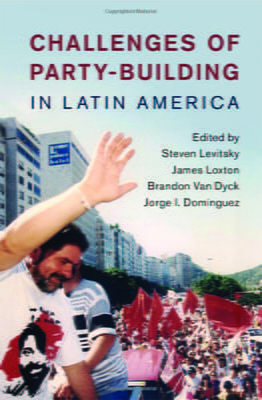A Review of Challenges of Party-Building in Latin America
Democracy and Party-Building

Challenges of Party-Building in Latin America edited by Steven Levitsky, James Loxton, Brandon Van Dyck and Jorge Domínguez (Cambridge University Press, 2016)
I started graduate school in September 1978, around the zenith of authoritarianism in Latin America. After the Argentine military coup in 1976, only three of twenty countries in the region were democratic (Costa Rica and Venezuela) or semi-democratic (Colombia). In most of the authoritarian regimes, parties were secondary actors or banned altogether. The literature on parties in the region was not very developed.
Times have changed. Sixteen of the seventeen countries with authoritarian regimes in 1976-77 experienced a regime transition between 1978 and 1990, with Cuba the sole exception. As these transitions unfolded, parties became more important actors. Over time, a substantial literature on parties and party systems emerged. At its best, this scholarship has offered insights to understanding parties in Latin America and has made major theoretical contributions to the broader works on parties and party systems.
Challenges of Party Building in Latin America is an excellent contribution to this literature. It analyzes challenges and successes of party building in the post-1978 wave of democratization in Latin America. It enhances knowledge about conditions for successful party building in an era of great challenges to that enterprise. The authors include an attractive mix of distinguished senior scholars and excellent younger colleagues.
In their introduction, co-editors Steven Levitsky, James Loxton and Brandon Van Dyck make an important theoretical contribution and bring cohesion to the volume as a whole. The introduction, which is essential reading for scholars interested in Latin American politics and for those interested in the comparative study of parties, points out that this is a challenging era for party building. It strikes a nice balance between highlighting the challenges to party building and observing that some successful new parties have emerged. Levitsky, Loxton, and Van Dyck count eleven parties created in 1978 or thereafter that won at least ten percent of the vote in at least five consecutive lower chamber (or unicameral) elections; these are the “successful” cases of party-building. The vast majority of new parties faltered.
Levitsky, Loxton, and Van Dyck argue that parties are more likely to take root if they build a base of partisans and a solid organization, and if they have a source of organizational cohesion. They carefully ground these claims in established literatures. This is a useful and creative way of thinking about how parties solidify—but it is exceedingly difficult in most contemporary Latin American democracies to build or even retain substantial numbers of committed partisans.
They contend that “extraordinary conflict” is the most fertile breeding ground for major new parties. Sharp conflicts such as “social revolution, civil war, authoritarian repression, and sustained popular mobilization” fosters stronger brands and attachments, creating stronger incentives for building an organization. Sharp conflict also serves as a source of organizational cohesion—the third element conducive to investing in building a party. Conversely, the muffled policy disputes during the short-lived Washington Consensus frequently gave rise to brand erosion. Routine democratic politics in Latin America in the post-1978 wave of democratization has not given rise to successful new parties, contrary to the expectations of earlier analysts. The introduction successfully weaves in key conclusions from the rest of the volume.
I completely agree that “extraordinary conflict” breeds stronger identities and is fertile ground for party building. But where should we demarcate the boundaries of what constitutes “extraordinary conflict?” There is no doubt that social revolution and civil war qualify, nor that the highly repressive phases of dictatorships usually do. Less clear is whether liberalizing phases of authoritarian regimes that sponsor competitive elections and sustained popular mobilization consistently constitute “extraordinary conflict.”
Spatial constraints make it impossible to describe the contributions of the other sixteen chapters in this hefty volume (550 + xxii pages), so I will single out a few favorites. Noam Lupu, in “Building Party Brands in Argentina and Brazil” (Chapter 3), argues that to be successful, new parties must build partisans. He further asserts that a clear brand is a necessary condition for building partisans. Party consistency and clear programmatic differentiation from their main rivals facilitate the development of strong party brands. These attributes helped the leftist PT (Workers’ Party) in Brazil build a clear brand and a strong base of party identifiers. Conversely, in Argentina, FREPASO, a center-left party created in 1994, quickly diluted its brand, leading to a collapse of partisanship and after 2001 to the party’s demise.
Although Lupu’s work on party brands and brand dilution is superb, Brazil’s PSDB (Social Democratic Party) is a contrary case of a new party that was electorally successful without creating many partisans. Since its creation in 1988, it has won the presidency twice (1994 and 1998) and came in second the last four elections (2002-14), and it has consistently captured powerful state governorships. Yet it has always had relatively few party identifiers, consistently below seven percent of survey respondents, raising the question of how some parties achieve extended success despite having few partisans. Social scientists do not have a good answer to this question, which I suspect will become important in the study of Latin American politics because few parties still have large numbers of stable and committed partisans.
In “The Paradox of Adversity: New Left Survival and Collapse in Brazil, Mexico, and Argentina” (Chapter 5), Brandon Van Dyck argues that left-of-center parties born under authoritarian regimes tend to invest more in building an organization than those born under democracy. Opposition parties born under authoritarian rule cannot rely on state resources or access to mass media to build support. Van Dyck illustrates the propensity of left-of-center parties created under authoritarian regimes to build organizations with the Workers’ Party in Brazil and the PRD (Party of the Democratic Revolution) in Mexico. Both parties experienced long times in the wilderness before they came to power at the national level. Because they invest heavily in building organizations, leftist parties created under liberalizing authoritarian regimes are often more durable and successful than those created under democracies. This is the “paradox of adversity.”
In contrast, because left-of-center parties that quickly rise to govern at the national level have access to resources and pressure to govern, they have little incentive to invest heavily in building an organization. Argentina’s FREPASO illustrates this point. Born under democracy in 1994, it came to power at the national level as part of a coalition in 1999, and flamed out spectacularly when the de la Rúa government (1999-2001) collapsed under the weight of a severe recession and massive protests in December 2001. FREPASO prioritized the use of mass media over the tedium of organization building, and this strategy came to haunt the party.
James Loxton’s “Authoritarian Successor Parties and the New Right in Latin America” (Chapter 9), analyzes authoritarian successor parties—“parties that emerge from authoritarian regimes, but that operate after transitions to democracy.” His path-breaking analysis explains why all successful new conservative parties in Latin America have been authoritarian successor parties. These parties have built-in assets (an “authoritarian inheritance”) that help them compete in democratic regimes—clientele networks, financial resources, a source of cohesion, territorial organization and a brand name. He illustrates his argument with the cases of ARENA (Nationalist Republican Alliance) in El Salvador and the UDI (Independent Democratic Union) in Chile. Both were created under authoritarian regimes by high-level regime sympathizers, and they enjoyed electoral success after transitions to democracy.
In “Insurgent Successor Parties: Scaling Down to Build a Party after War” (Chapter 10), Alisha C. Holland examines reasons for the wildly different rates of success of insurgent movements that transform themselves into political parties after war. She adds to the evidence that a sharper programmatic identity can be good for building parties. By contrasting the cases of the FMLN (Farabundo Martí National Liberation Front) in El Salvador and the AD M-19 (M-19 Democratic Alliance) in Colombia, she argues that insurgent successor parties are more likely to fare well if they don’t dilute their brand name by veering sharply to the center. Created as a revolutionary guerrilla front in 1980, the FMLN transformed itself into a party in 1992, becoming one of the most electorally successful leftist parties in Latin American history. In part, it enjoyed success because when it traded bullets for ballots, it preserved its image as a leftist party and eschewed opportunistic alliances. The former Colombian guerrilla organization, AD M-19, fared well in its first two elections, in 1990 and 1991. However, it quickly disappeared, a victim in part of brand dilution by moving to the center.
Holland argues that focusing on first winning subnational elections can help insurgent successor parties build durable organizations and sustain electoral success. Winning local office can enable former combatants to build a reputation for effective governance and to recruit new supporters without diluting their ideological brand.
Raúl Madrid (Chapter 11) argues that only two ethnic parties, the MAS (Movement Toward Socialism) in Bolivia and the Movimiento Unidad Plurinacional Pachakutik in Ecuador, have been electorally successful in Latin America—the second far less than the MAS. In a region with many deep ethnic divides, why has ethnicity not been more salient in party competition? Madrid suggests that a “low level of ethnic consciousness and the fluidity and ambiguity of race and ethnicity” in Latin America have hindered the building of ethnic parties. The two success cases built strong linkages to social movements that provided organizational and material resources and used broader-based populist appeals as ways of overcoming the difficulties of building ethnic parties.
David Samuels and Cesar Zucco’s “Party Building in Brazil: The Rise of the PT in Perspective” (Chapter 12) focuses on the PT’s success in building partisanship during the 2000s (PT partisans have declined precipitously in the last several years). It partially qualifies Lupu’s argument that clear programmatic differentiation is essential for branding. By 2010 about a quarter of Brazilian voters were PT identifiers. Contrary to what one might expect based on Lupu, PT identifiers proliferated even as the party moderated considerably after winning the presidency in 2002. Samuels and Zucco attribute this success to the institutionalization of grass-roots participation combined with programmatic centralization. The PT retained a strong brand despite moving toward the center and forging governing alliances with conservative parties—a point that Jorge Domínguez also makes in his insightful concluding chapter, emphasizing that many successful Latin American parties have thrived for a long time despite brand dilution (pp. 477-479). The steep decline in PT partisans since 2012, however, suggests that Lupu is also correct: the combination of brand dilution and bad governing performance is often fatal for partisanship.
“Why No Party-Building in Peru?” by Steven Levitsky and Mauricio Zavaleta (Chapter 15) offers a fascinating analysis of an extreme case of party weakness. One might expect parties of presidents who have presided over robust economic growth and sharp declines in poverty to use these successes to cultivate loyalties among citizens and to build an organization. The Peruvian case defies these expectations. Peruvian politicians have adopted party-less strategies and mechanisms to gain electoral success. They are free agents with little attachments to party labels.
Levitsky and Zavaleta argue that Peru is a democracy without parties. Although I believe that it overstates the case to say that there are no parties in Peru, the evidence of party weakness is unassailable. The Peruvian case raises questions about the conventional wisdom regarding the indispensability of parties for democracy: must parties still create modern democracy, and is democracy still unthinkable without parties? Still, consistent with the conventional assumption, Levitsky and Zavaleta note some dysfunctional consequences of party weakness, such as hampered accountability and representation.
Most of the chapters in Challenges of Party-Building are very good and the best are outstanding, but if I have one criticism of this agenda-setting volume, it is that the editors might have made the difficult decision to trim a couple of those that they judged to be lesser contributions. The book is excellent, but I’m not sure that we needed 17 chapters and 550 pages.
Parts of this review were previously published in Scott Mainwaring, “Party System Institutionalization, Party Collapse and Party Building,” Government and Opposition: An International Journal of Comparative Politics, vol. 51, no. 4 (2016), pp. 691–716.
Scott Mainwaring is the Jorge Paulo Lemann Professor for Brazil Studies at the Harvard Kennedy School.
Related Articles
A Review of Patriots and Traitors in Revolutionary Cuba, 1961-1981
I remember when I first heard Lillian Guerra speak: over fifteen years ago, at Brown University, about her third book, Visions of Power in Cuba: Revolution, Redemption and Resistance (1959-1971).
A Review of Los Niños del Amazonas: 40 Días Perdidos en la Selva
Los niños del Amazonas. 40 días perdidos en la selva is the first true book by Colombian journalist Daniel Coronell, whose long and impressive career speaks for itself: news director of manifold networks; recipient of prestigious recognitions such as Emmys, Peabodys and Simón Bolívar prizes; and arguably the most widely read columnist in Colombia, where he is as much admired as he is feared.
A Review of Channeling Knowledges: Water and Afro-Diasporic Spirits in Latinx and Caribbean Worlds
Water is a powerful tenet of Afro-diasporic religions that troubles academic disciplines and racial categories that define state, military and geographic borders.




